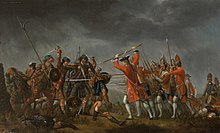David Morier

Pierre David Morier (* around 1705 in Bern ; † January 1770 in London ) was a Swiss painter who became famous for his equestrian portraits of the royal family of today's United Kingdom , especially during and after the time of the War of the Austrian Succession . Morier also distinguished himself as a battle and animal painter. One of his most famous battle paintings is that of the Battle of Culloden .
Career in Great Britain

Little is known about David Morier's life in Switzerland. Morier came to England in 1743, where he became a sought-after portraitist for equestrian portraits. Within the first years of his arrival in England, he made the acquaintance of William Augustus, Duke of Cumberland . The Duke was the Commander in Chief of the British Army at the time. The Duke recognized Morier's talent and encouraged him to the best of his ability. Morier became the Duke's constant companion and followed him and his army to Scotland in the Battle of Culloden , which Morier captured in his famous painting An Incident in the Rebellion of 1745 . This painting is now in the Queen's Ante-Chamber at Holyrood Palace in Edinburgh .
During his time with the Duke of Cumberland, other famous works were created by Morier, including the famous equestrian portraits of the Duke of Cumberland, the portraits of the British Kings George II and George III. as well as the series of portraits now known as the Grenadier Paintings . Portraits of soldiers who provide information about the condition of the uniforms and equipment used by British soldiers up to the time of the Seven Years' War .
Due to the defeat in the Battle of Hastenbeck , the Duke lost his military position. As a result, Morier's career came to an end under the duke's protection and ended with his death in 1765 at the latest. Morier received an annual pension of 100 pounds sterling from him - presumably until the duke's death . After the pension disappeared, Morier ran into financial difficulties and was sent to Fleet Prison because of his debts in 1769 , where he died in January 1770. His colleagues from the Society of Artists of Great Britain paid for his funeral. Morier was buried in St. James's Church, Clerkenwell , London on January 8th.
plant
David Morier's work is primarily characterized by its attention to detail, especially in the case of uniforms , medals and decorations as well as saddles , saddlebags , saddlecloths and the bridles of horses. His equestrian portraits each show a striking representation of the horse's head, with shining, slightly protruding eyes and the deliberately rounded nose with large nostrils and pointed ears. The horse and rider are each held in a raised pose, with the horse usually walking.
Morier's works have been preserved in numerous museums and private collections, including the Royal Collection and the National Portrait Gallery .
Exhibitions
David Morier showed some of his works at the Society of Artists of Great Britain's first exhibition in 1760. He also exhibited there in 1762, 1765 and 1768. He mostly showed equestrian portraits. Last year he also showed a painting called An Old Horse and the Farmer .
Web links
Individual evidence
- ^ A Soldier-Like Way, The Material Culture of the British Infantry 1751-1768 , Track of the Wolf, Inc., Elk River, MN, 2007, p. 1.
- ^ Sikart: Lexicon on Art in Switzerland: Pierre David Morier , website.
- ^ Sikart: Lexicon on Art in Switzerland: Pierre David Morier , website.
- ^ Lionel Henry Cust: Morier, David ; in Lee, Sidney. Dictionary of National Biography 39.Smith , Elder & Co, London 1894.
- ^ Lionel Henry Cust: Morier, David ; in Lee, Sidney. Dictionary of National Biography 39.Smith , Elder & Co, London 1894.
- ^ Lionel Henry Cust: Morier, David ; in Lee, Sidney. Dictionary of National Biography 39.Smith , Elder & Co, London 1894.
| personal data | |
|---|---|
| SURNAME | Morier, David |
| ALTERNATIVE NAMES | Morier, Pierre David (full name) |
| BRIEF DESCRIPTION | Swiss painter |
| DATE OF BIRTH | around 1705 |
| PLACE OF BIRTH | Bern |
| DATE OF DEATH | January 1770 |
| Place of death | London |
